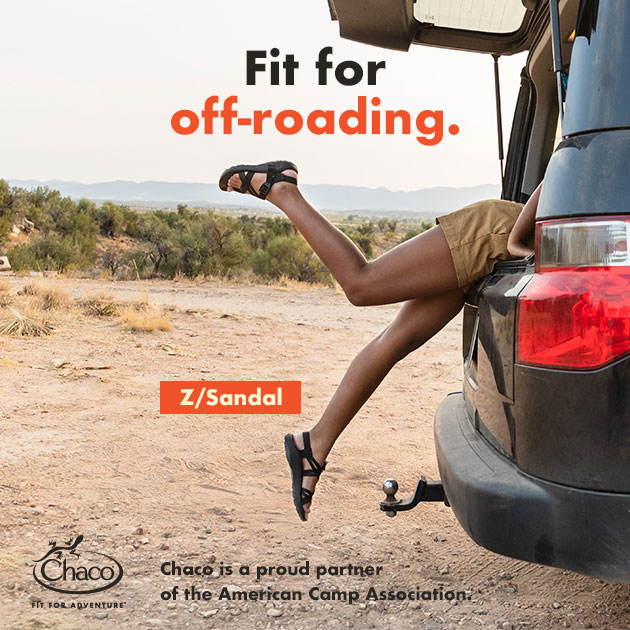Did you know you’re walking around with a set of lenses that uniquely shape your understanding of the world? Implicit bias is the idea that we view the world through lenses that have been formed by all of our experiences from the time we were born up to today. This includes the way we were raised, our values, our family history, our education, and even our camp experiences. No two people see things the same way — we each have our own lenses.
Bias is the way our brains are wired to quickly process the information around us, based on previous experiences. If we had to consciously process everything as if it were a new experience every time, we would not have survived as a species. Bias is what allows us to operate on autopilot, lets us fill in the blanks very quickly to make sense of information, and gravitate toward the familiar without expending a lot of time or energy. Our brains need to make decisions quickly, and biases let our brains form shortcuts in our neural pathways to speed up our understanding of information.
Let’s try something. Quickly say the word “shop” out loud six times: “Shop, shop, shop, shop, shop, shop.” Now answer this question out loud: “What do you do at a green light?”
Did you want to say “shop”? Your neural pathways were very quickly reprogrammed by repeating a word several times. Your selection of a word that rhymed was your implicit bias responding to the fact that shop and stop rhyme. It is really tough to stop these reactions! What you can do is slow down your actions until you have had enough time to check your assumptions. This phenomenon is not your fault, but it is something you should be aware of.
Here’s something else to try. Read the following out loud to yourself:
Did you read every word in each triangle?
Ultimately, our brains want to make sense of information, so sometimes there is a disconnect between what people see and what they think they see. How might this impact the way we interact with one another? Just like we may not notice the duplicate words in these triangles, we assume certain things about people based on small amounts of information. (For instance, we may assume a person’s gender identity based on their gender expression, we assume someone’s class based on the color of their skin, etc.). This is how our brains work; there is nothing to be embarrassed about, but we should work to become more aware of our biases.
You might be thinking, “So what’s the problem with implicit bias if it’s just the way my brain is wired?” Bias can become dangerous when it goes unexamined and impacts people around us. Or to put it differently, bias becomes dangerous when it means we’re treating people unfairly based on our perceptions of their identities. Let’s talk about how bias relates to people and camps.
Six types of bias often affect us at camp:
- Affinity Bias. Birds of a feather flock together. We tend to seek out people or scenarios that are familiar to us. Think about your friend group. We gravitate toward each other because of similar experiences. This can be a good thing because it helps us build community. However, it can also create exclusionary environments. At camp, this looks like similar staff members hanging out together on days off while those individuals who are dissimilar do something else on their own.
- Confirmation Bias. With incomplete information, we tend to fill in the blanks based on our previous beliefs and experiences. People tend to pay more attention to and favor information that confirms beliefs they already have. We trust information that confirms our preconceptions. At the same time, we ignore or dismiss other perspectives if they are not our own, even when they are true and valid. This shows up at camp when we read last summer’s camper report and find out Chris was suspected of stealing another camper’s comb. We stay on the lookout this summer for evidence that Chris is stealing and blame Chris for the missing deck of cards (when it was in a counselor’s backpack all along).
- Attribution Bias. These are the errors made when trying to make sense of or find reasons for our own or others’ behaviors. A camp example would be assuming a camper is just being lazy when they don’t participate in cabin chores, instead of realizing that the camper has never used a broom and dustpan before and doesn’t know how to accomplish the chore.
- Projection Bias. We think that everyone thinks like we do. That is, we project our worldviews onto others and assume they have the same thought processes. Further, we value “present me” highly but have difficulty thinking about “future me” and our changing interests and goals. This might show up at camp when we eat a big meal before planning the cabin cookout for next week. But since we feel full now, we don’t plan enough food for campers because we underestimate how hungry we’ll be at that time (after a long day of swimming and challenge course fun).
- Anchoring Bias. We tend to get overly influenced by the initial piece of information we learn. When we make a decision, we put too much emphasis on the first thing we know that serves as a reference or focal point. At camp this might mean we use our first impressions of a camper to determine how we treat them for the rest of the session. For example, if a camper is shy and quiet on the first day of camp, we choose not to invite that camper to be the hike leader on the second day of camp, thinking that this camper would be uncomfortable in that role based on their shyness the first day.
- Bias Ignorance. This bias occurs when we fail to recognize that we have a bias. In a study of more than 600 Americans, 85 percent believed they were less biased than the average American, and most could identify cognitive biases more easily in others than themselves (Pronin, Lin, & Ross, 2002). Many of us disagree or ignore the effects of biases in our lives, even when we’re aware of them. At camp, this sounds like people saying, “I don’t judge others,” or “I don’t see the color of people’s skin.”
Biases lead to stereotypes (how we expect a member of a group to have certain characteristics without having actual information about that individual) and other negative actions. While you’re not responsible for your first thought, you are responsible for your next action.
So how do we get better at dealing with our biases?
Step One
Become self-aware. Regularly reflect on your decisions and assess yourself kindly and honestly. Did you make that decision based on your preconceptions, or did you use facts or perceptions that were at odds with your beliefs? Practice mindfulness that encourages you to think about your thinking. Everyone experiences automatic thoughts and images. Be cognizant of these occurrences and challenge them. If you find yourself thinking that someone is behaving in a way that is stereotypical of their group, think about other factors that might be influencing their behavior. For example, is anxiety about being in a new situation at camp leading a camper to behave in a way that is not as outgoing as you’d expect?
Step Two
Become aware of when biases are likely to emerge at camp and when individuals are at risk of taking action on their biases.
- During the first day of camp when welcoming and getting to know campers or setting up and modeling expectations for group interactions
- During small talk and transitions between activities, such as asking campers about their families or backgrounds using stereotypes or assumptions
- Naming things (cabins, for example) and games or activities based on traditions and language that may have roots in negative beliefs about people from marginalized or oppressed groups
Step Three
Reduce your exhaustion and fatigue. Not getting enough rest and working hard reduces your ability to make thoughtful decisions and work to overcome biases in your actions. Of course, your camp nurse will be happy too, because rested staff are less likely to get sick or injured.
Here are four ways to interrupt bias:
Ten Helpful Phrases You Can Use to Respond to Bias
- “What you said just made me bristle a little. Can you tell me what you meant?”
- “What makes you ask that question/say that ____?”
- “It sounds like you’re really passionate about this issue. Can you tell me why?”
- “I was really upset when you said ____ and was unable to hear the rest of what you said. Can we go back and discuss it?”
- “Ouch! I’m really shocked by that statement. Can you give me a minute to think?”
- “I do not find the joke you just told funny because ____.”
- “So, why exactly is that joke funny?”
- “I feel that what you just said breaches our (cabin contract, group agreement, group norms).”
- When people from a dominant group are taking up too much air time, say “I’d like to hear what ____ has to say” (focusing on the person who is being silenced) or “____, it looked like you wanted to say something.”
- “Yesterday someone said ____. It made me uncomfortable and we need to talk about it before we can move forward with our (trip/work/time at camp).”
Next Steps
- Take the Implicit Association Test at https://implicit.harvard.edu/implicit/. This online test measures attitudes and beliefs that people may be unwilling or unable to report.
- Read more in Camping Magazine’s Social Justice Series at ACAcamps.org/topics/social-justice and Cultural Competence at ACAcamps.org/topics/cultural-competence.
- Learn about other biases by exploring the “50 Cognitive Biases in the Modern World” infographic at visualcapitalist.com/50-cognitive-biases-in-the-modern-world/.
- Read:
- Thinking Fast and Slow by Daniel Kahneman.
- Blindspot: Hidden Biases of Good People by Mahzarin R. Banaji and Anthony G. Greenwald.
- Biased: Uncovering the Hidden Prejudice That Shapes What We See, Think, and Do by Jennifer L. Eberhardt.
As you think about the lenses through which you make sense of the world, consider the potential impacts of acting on what you know to be “true.” We owe it to our campers and our camp communities to be vigilant and careful with our lenses.
Ann Gillard, PhD, has worked in youth development and camps for more than 25 years as a staff member, volunteer, evaluator, and researcher.
Reference
Pronin, E., Lin, D. Y., & Ross, L. (2002). The bias blind spot: Perceptions of bias in self versus others. Personality and Social Psychology Bulletin, 28(3), 369-381.



